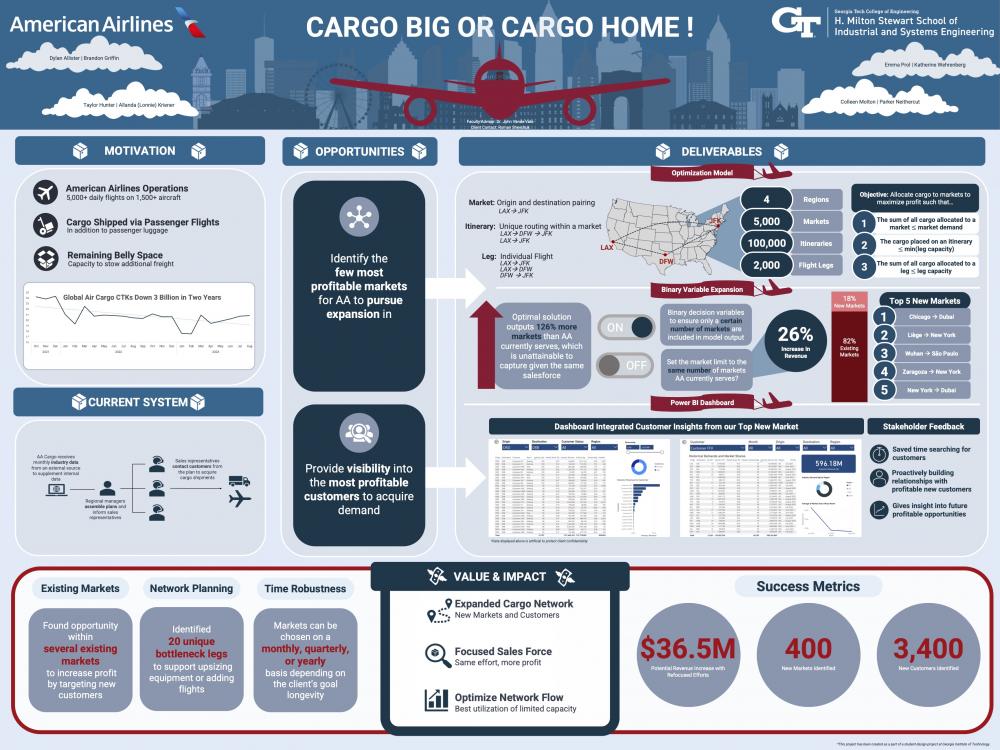Client Context
The client, Roman Shevchuk, is a manager of operations and development in the America Airlines cargo division based out of Fort Worth, Texas. He tasked the team with improving the process of procuring cargo shipments. Currently, managers across four regions are responsible for developing sales plans for the sales representatives. The objective of a sales plan is to create a list of customers to contact to fill flights with cargo that generate the largest profit. Sales representatives enact the sales plan by contacting customers and securing shipments.
Project Objective
AA has been seeking opportunities to mitigate the impact of the recent decline in global air cargo demand. The team found that of the 5,000 markets AA Cargo can serve, they are currently serving about 1,600. With high load factor goals and extra capacity in planes, there is an opportunity to strategically expand AA Cargo’s market network to include new, more profitable markets. Additionally, there is an opportunity to give the sales teams greater visibility into potential customers within these current and new markets so that AA can actualize demand in each market.
Design Strategy
The team’s design strategy approach began with assessing the profit potential of a market, by considering projected demand, market share, itinerary profitability, revenue, and leg capacity.
The data utilized includes market demand and customer data from WorldACD (WACD) and internal data from American Airlines (AA) regarding itineraries, variable shipping costs, and leg capacities. Assumptions integral to the model include the accuracy of forecasts, insignificant fixed costs, and the comprehensive inclusion of variable costs in the data. The need for optimization arises from AA's hub and spoke network design, leading to competition for limited cargo capacity on flight legs shared amongst various itineraries.
The team’s model computes the expected profitability of an itinerary and employs a multi-commodity network flow model for optimization. The main decision variable represents the flow of cargo, in kilograms, allocated on each itinerary in a market, in a certain month. Key constraints include: 1.) ensuring that cargo allocated across itineraries in a market in a month does not exceed the overall projected market demand for AA and 2.) ensuring that leg capacities across markets and within markets are respected. The overall objective function maximizes profit. Additionally, the team included flexibility in the model via binary decision variables that constrain the number of markets the model is allowed to solve, on a monthly or quarterly basis. This allows for more feasible planning, and ensures that staff resources, time, and cargo allocated is directed toward key, few, profitable markets AA wishes to pursue.
The validation process involved subset validation on the Latin America + Miami (LATAM) region and validation on AA's assumed current global network. Results from June-August 2023 indicate a mere ~2% difference between the model’s optimal revenue output and AA Cargo’s widebody cargo revenue actuals for both the LATAM and global networks. Additional output validation is observed by the top markets by revenue the model outputs, which were confirmed to match AA’s top markets.
Deliverables
The team developed a data preparation script feeding into an optimization model to determine the most profitable flow of cargo for the existing network as well as potential network expansion opportunities. This model provides sales managers and representatives with insights into markets worth pursuing. The model's output is presented through a Power BI dashboard, offering a user-friendly display for managers. The dashboard visualizes the markets output by the model and customers known to ship through these markets. This feature allows managers to explore other potential markets the customers may be involved in as well as their shipping history with AA to better prepare for sales meetings. This dashboard will be utilized in the existing planning flow of sales managers as they create plans to acquire the most profitable cargo.
Value and Impact
Using the average number of markets AA currently serves monthly, the initiative holds the potential to increase quarterly revenue by approximately 26%. Additionally, it identified 400 new markets and approximately 3,400 new customers to target for the Summer 2023 quarter. The model can also pinpoint constrained legs with remaining profitable demand, enabling the team to present a case to the network planning team for capacity increases on those legs.


